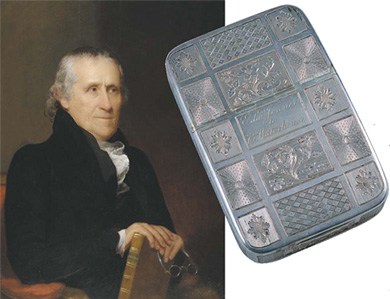Benjamin Waterhouse, M.D. (hon.) 1786, called smallpox the "devouring monster." Today it is the only naturally occurring disease considered to have been eradicated (permanently, let us hope). Waterhouse played a pivotal role in its demise.
 |
| Above, both at the Countway Library: Waterhouse, painted by James Frothingham in 1831. The snuffbox, a gift from Jenner to Waterhouse and so inscribed, arrived full of quills impregnated with cowpox vaccine matter. Waterhouse declared, "Dr. Jenner has been to me what the sun is to the moon ." |
| Portrait courtesy of the Harvard University Portrait Collection, ©President and Fellows of Harvard College, Photograph by Katya Kallsen. Snuff box photograph courtesy of Countway Library of Medicine, Harvard Medical School. |
He became the Hersey professor of the theory and practice of physic at the infant Harvard Medical School in 1783. Then, the best thing known to do to protect someone from smallpox was to inoculate him or her with matter from a pustule on a smallpox sufferer. This ancient procedure was introduced into the American colonies in 1721 by physician Zabdiel Boylston at the urging of Rev. Cotton Mather, A.B. 1678. Boylston demonstrated what was then called "variolation" by inoculating his son and two slaves, who developed mild cases of the disease and quickly recovered. He inoculated 244 persons in all, including about 20 members of Harvard College. Only six died from the inoculation, which struck Boylston as good odds. But the public thought the practice mad and urged the authorities to try Boylston for murder. Someone threw a lighted grenade into the Reverend Mr. Mather's house for his public backing of the alleged poisoner.
Near the end of the century, English physician Edward Jenner found that people who contracted cowpox, a mild disease spread to milkmaids and others who got cozy with cows, appeared to become immune to smallpox. He concluded that a cowpox inoculation a vaccination (from vacca, Latin for "cow") could spare humanity from smallpox. Waterhouse read of Jenner's work and begged cowpox vaccine material from him. In 1800, "to convince the faithless," he wrote, "and silence the mischievous," Waterhouse vaccinated his four children and two servants. The six were then exposed to smallpox, without ill effect.
Waterhouse went on to perfect safe vaccination and to wage an aggressive public-health campaign promoting it. The Countway Library of Medicine at the medical school mounted an exhibition in 2000, curated by John Eckert, reference librarian of rare books, to mark the bicentennial of Waterhouse's work. It persists on-line at www.countway.harvard.edu/rarebooks/waterhouse/index.html, a richly documented account of an early, ultimately successful, offensive to slay the devouring monster.





